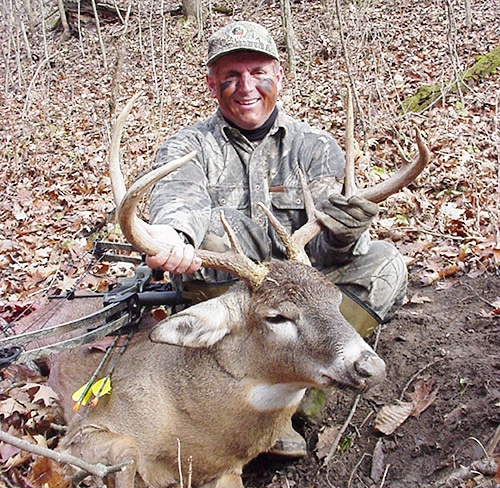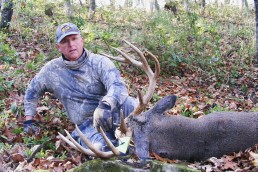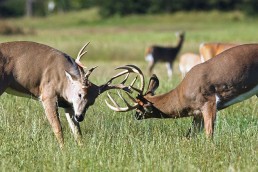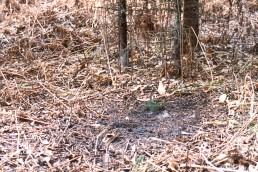‘Gold Mine’ Rut Stands
SHARE THIS POST
Nothing is more important to a whitetail buck during the actual peak of the rut than breeding—period. The sooner a bowhunter realizes this, and plans his or her hunting strategy accordingly, the more successful he or she will be. Buck sign such as big rubs, as well as large ground scrapes, are no longer the key to success when the rut is on. Once the female hormone estrus wafts through the woods, every single male whitetail is sure to focus on nothing but finding a doe.
Of course, before does emit their lusty love potion estrus, bucks rub trees and scrape the ground with a vengeance. The bigger the buck, the more often it seems to perform these tasks of territoriality. These were certainly the keys to pre-rut October success. However, it’s important to understand that most of the rubs and scrapes you stumble onto on your ventures to and from your stand are yesterday’s news once females in the herd come into heat. Doe location and travel then become the focus of every buck, small, medium or large.
With that in mind, concentrate all of your efforts from November on, hunting near or even right inside a doe bedding area. This is particularly true on all morning hunts. Mornings can be far more productive during this time period than evenings, even though a golden rut hunting opportunity can occur at any moment. However, rutting whitetails seem to be most active during the coldest portion of the day, often the first three hours of daylight. If air temps remain chilly at mid- morning, it’s a good bet that buck movement will likely continue right up through lunchtime.
In fact, mid- to late-morning is perhaps the most underrated time during the peak of rut. Weary bucks that have been actively chasing and trolling all night long might bed down briefly at first light. But a slight whiff of estrus carried through the woods by an initial mid-morning breeze will get them back on their hooves. You want to be in your stand when this happens for sure.
Sitting in a stand overlooking a prime doe bedding area is the closest thing to a guarantee this time of year. Pack a lunch if the weather forecast has a cold front arriving. If midday temperatures remain below 40 degrees, rut action is likely to extend well beyond the first few hours of daylight. Add overcast skies and a crisp, northerly breeze to the scenario and you might witness periodic “rutty” action all day long. It’s almost a sin to leave your stand during these prime conditions.
Are you enjoying this post?
You can be among the first to get the latest info on where to go, what to use and how to use it!
Locating doe bedding areas is simpler than you think. Stealthily slip through your favorite hunting areas during midday and scout out sections with thicker underbrush, deadfalls and heavy cover. As soon as you “bump” a doe, stop! Now scan the surrounding area for a potential stand site. Of course, take wind direction, terrain and the existence of deer trails into consideration, then quickly zero-in on a tree that works for a stand setup. Hang (the stand) and hunt as soon as you can. You can always make adjustments to your stand setup later once you begin to observe deer travel.
If you bump multiple does—or even a buck with a doe—you are definitely inside the heart of a doe bedding area, the true gold mine of rut stands. I often refer to these spots as “rut zones.” The search is over; do not spend any more time wandering around. Concentrate on one mission: pinpointing a tree to hang your stand in or a good spot for a ground blind. Once you find that spot, erect the treestand or pop up your ground blind and start hunting. At the very least, prepare the site for tomorrow morning’s hunt. Then back out and get ready to reenter the rut zone before first light.
Quite often, your initial set will not be right on the money. A few hours and some deer movement through the area will tell the story. Best-case scenario is you picked the right tree and you have close range deer movement. Worst-case scenario—you will need to make a further adjustment in your setup. If the later turns out to be the case, closely “glass” the area with your binoculars, trying to pinpoint a better tree. Watching the local herd travel through the area undisturbed gives you the priceless information. Your goal is to be in bow range of the majority of deer that travel through this section. Once you dial this spot in, you’ve likely located a stand site that will produce a good buck year after year.
Finally, always consider an exit strategy. In other words, how are you going to get out of this spot at the end of a hunt if unsuccessful? Use the terrain and/or strong wind as your ally to slip out undetected. If does are actually bedding around your stand site, it would be a huge mistake to simply climb down and alarm them. If you want that stand to be good again for future hunts, you need to establish an entry and exit strategy. That’s why you need extra food and water. You might be stuck in your stand for longer than a few hours. If there are deer bedding around you, resist any urge to leave—a big bruiser buck could show up here at any moment.
MWO
SHARE THIS POST
Did you enjoy this post?
You can be among the first to get the latest info on where to go, what to use and how to use it!
Joe Bucher
Joe Bucher is a Freshwater Fishing Hall of Fame Legendary Angler, book author, lure designer and host of Fishing with Joe Bucher TV series.



